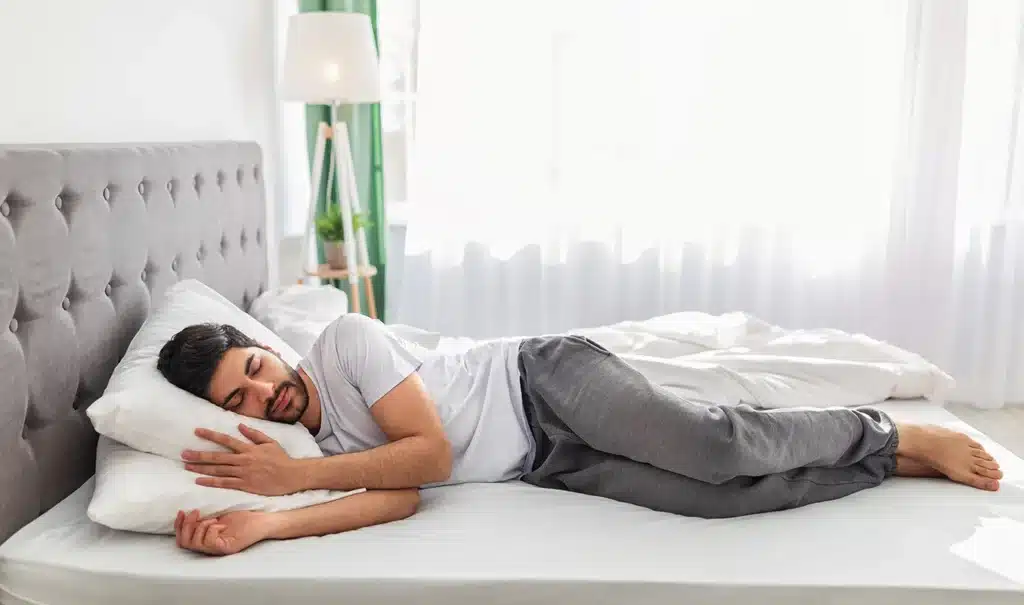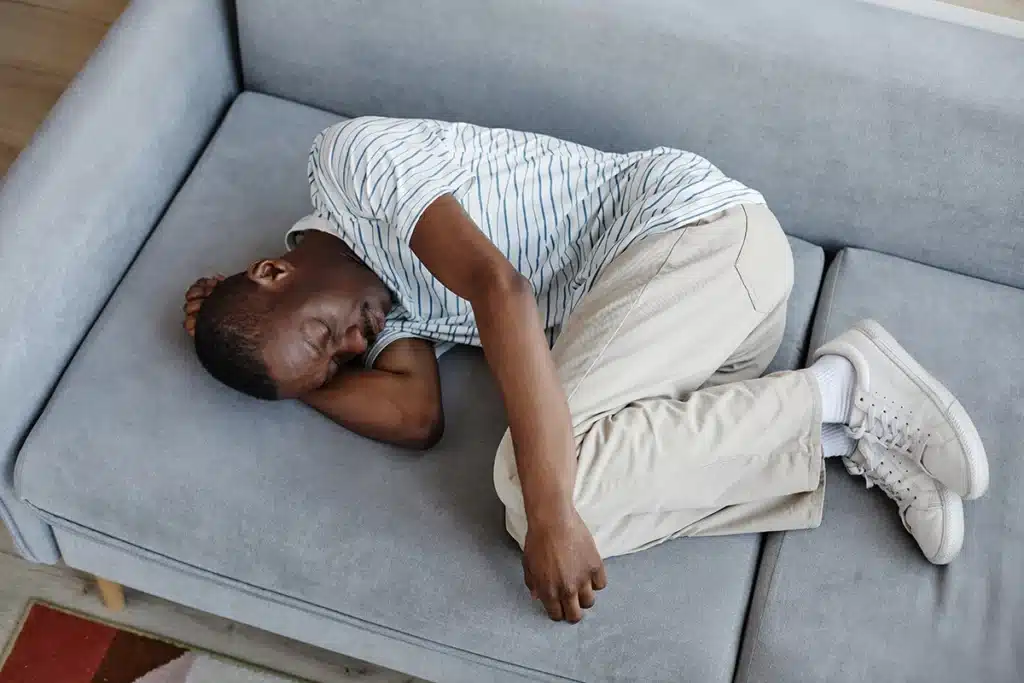
Table of Contents
ToggleUnraveling the critical connection between back pain relief lying down and optimal sleep quality stands as a beacon of hope for those eager to arise rejuvenated.
Every night, millions across the globe lie down, filled with hope for relief, only to find themselves betrayed by their very posture, the supposed source of rest and relaxation.
Together with the experts at Long Island Neuroscience Specialists, embark on a journey to restore not just your sleep but your overall well-being, ensuring every lying down moment becomes one of relief and recovery.
Armed with knowledge and insights from the experts at Long Island Neuroscience Specialists, we delve deeper into the myriad sleep positions and their intricate relationship with back health.
After all, when it comes to back pain relief lying down, every tiny adjustment can make a world of difference.
Often touted as the ‘king of sleep postures’, lying flat on your back distributes body weight uniformly across the vast terrain of your spine. This equal distribution minimizes pressure point creation, offering optimal support to the back’s natural curve.
For those who’ve woken up with a stiff back, making the transition to this position can be a game-changer. To enhance this posture further, consider placing a pillow under your knees. It can alleviate the strain on your lower back, granting many the elusive back pain relief lying down.
A glimpse into the animal kingdom or a child’s peaceful slumber reminds us that side sleeping might be an inherent posture coded in our genes. But, like all things in life, a bit of optimization can elevate this natural pose.
While it’s cozy and fetal-like, it requires some tweaks for the modern adult dealing with back woes. Using a taller pillow helps maintain the neck’s alignment with the spine.
And that small pillow between the knees? It’s not just for added comfort—it’s a strategic placement that levels out the pelvis, minimizing lower back stress.
Venturing into slightly controversial territory, stomach sleeping is a love-it or hate-it kind of position. For the devoted belly sleepers, this pose is non-negotiable. However, it can sometimes be the sneaky culprit behind back pain.
The spine, in its natural state, has an ‘S’ curve, and lying on the stomach can pull it out of alignment. But fret not, there’s a way to still enjoy this position without the aches.
By introducing a flat pillow under the abdomen or hips, one can prevent the midsection from sinking, thereby maintaining a healthier spine alignment.
And when it comes to cradling your head, opt for a flatter pillow to keep that neck in check.
This position, reminiscent of our earliest form in the womb, isn’t just for nostalgia. Curling up slightly, knees drawn toward the chest, is known to work wonders for individuals with a herniated disc.
The gentle curl helps open up the spaces between vertebrae, reducing the pressure on the spinal disc, thereby offering back pain relief lying down.
It’s a protective, comforting position that can be especially beneficial for those with specific spinal conditions.
The modern age has brought with it the luxury of adjustable beds and recliners. For some back pain warriors, this is the pinnacle of relief. Reclining isn’t merely about indulgence; it’s about finding an angle where the spine feels most at ease.
Those with conditions like isthmic spondylolisthesis have found that reclining positions reduce pain, as it creates an angle between the thighs and trunk, reducing the pressure on the spine.
The journey of back pain relief lying down isn’t about blindly adhering to universally accepted postures, but about understanding and adapting them to one’s unique needs.
With this newfound wisdom, may your nights be filled with peaceful, restorative sleep, and may you rise, each day, with a rejuvenated back!

Your spine isn’t just a random stack of bones; it’s a marvel of biomechanical engineering. Think of it as a perfectly crafted bow, intricately strung with a delicate balance.
When you’re upright, the spine bears the weight of your body, and when you lie down, the dynamics change, affecting the tension and alignment of this ‘bow’.
So, if you’re on a quest for back pain relief lying down, getting acquainted with the intricate mechanics of your spine in different positions isn’t just helpful—it’s crucial.
The tiniest tweaks in your sleeping position can have profound effects. Sometimes, the key to relief is as simple as placing a pillow beneath your knees or changing the angle of recline.
Specialized pillows, tailored mattresses, or even lumbar rolls can be your allies in this battle against back pain. These aren’t just accessories; they’re tools designed to complement the natural curve of your spine, promoting back pain relief lying down.
Absolutely! Lying flat can be akin to hitting the reset button for your spine. In this position, the pressure distributes more evenly across your back, reducing stress on any particular point.
For many, this is the go-to posture for back pain relief lying down. It allows the spine to rest in its natural alignment, minimizing the chances of undue strain.
However, remember that everyone’s back is unique. While lying flat can be the golden ticket for some, others might need slight adjustments to find their sweet spot of comfort.
Here’s the low-down: sitting for prolonged periods, especially with poor posture, can wreak havoc on your spine, causing misalignment, stress, and increasing the risk of back issues. Those hunched-over hours in front of computers or TV don’t do any favors to your lumbar region.
On the other side, lying down, especially in a posture-friendly manner, often provides the much-desired back pain relief lying down. It allows your spine to decompress and muscles to relax. However, balance is key.
While lying down can be beneficial, it’s also essential to move and stretch intermittently. Mixing up your positions can prevent muscle fatigue, ensuring you keep stiffness and discomfort at bay.

The intricate dance between our body’s internal clock and inflammation plays a significant role. As we sink into the night, our body’s circadian rhythms, which govern various physiological processes, can cause inflammation levels to surge.
This increase is due to the body’s natural response to heal and repair itself during sleep. However, when inflammatory back pain is part of the equation, this nighttime rise can lead to heightened discomfort and restlessness.
Some research even suggests that our pain threshold is lower during the late evening and early morning, making us more susceptible to feeling the brunt of inflammation. This knowledge underscores the importance of understanding back pain relief lying down.
Finding a sleep position that can alleviate this intensified discomfort is not just about pain relief; it’s about harnessing the restorative powers of sleep.
Sleep isn’t merely a break from our daily grind. It’s when the body undergoes repair, regeneration, and detoxification. While back pain can be an immediate concern, chronic pain conditions can ripple out, impacting mental clarity, mood, and even cardiovascular health.
Finding the right posture for back pain relief lying down is more than just physical comfort; it’s a cornerstone for maintaining a balanced, healthy life.
By optimizing sleep positions, one can pave the way for a more energized, pain-free day ahead.
Home remedies have their place in providing temporary relief, but they’re not always the ultimate solution for chronic back pain. There comes a point when expert advice and intervention become paramount.
Prolonged, persistent pain is a signal from our bodies that something is amiss, and it’s crucial to address the root cause rather than merely the symptoms.
Over-the-counter pain relievers might offer quick relief, but they can sometimes mask the underlying issue and might even introduce unwanted side effects.
This is where Long Island Neuroscience Specialists step in. Their expertise in the realm of neurology and spine health ensures that patients receive comprehensive care, tailored treatments, and a roadmap to recovery.

We’ve journeyed through the intricate alleys of back pain, understanding its anatomy, and unraveling the secrets of back pain relief lying down. The road to a pain-free back isn’t riddled with complexity.
Sometimes, all it takes is lying down the right way. Yet, the key is not just knowing but applying this knowledge consistently.
The harmony between our spine and our sleeping habits plays a vital role in our overall well-being. With the right posture and awareness, we can navigate the maze of back pain, ensuring restful nights and energized days. Remember, the foundation of good health often lies beneath our pillows.
Get rid of your back pain today! Make an appointment at Long Island Neuroscience Specialists.
GET IN TOUCH +
285 Sills Road
Building 5-6, Suite E
East Patchogue, NY 11772
(631) 475-5511
184 N. Belle Mead Road
East Setauket, NY 11733
(631) 675-6226
GET IN TOUCH +
285 Sills Road
Building 5-6, Suite E
East Patchogue, NY 11772
(631) 475-5511
184 N. Belle Mead Road
East Setauket, NY 11733
(631) 675-6226
SUBSCRIBE TO OUR NEWSLETTER +
Send us a Google review. Click this link and let us know how we did!
Review us on Yelp too.